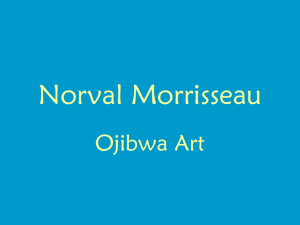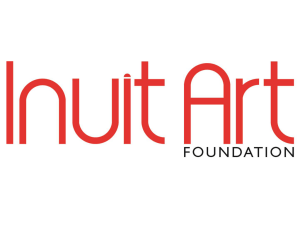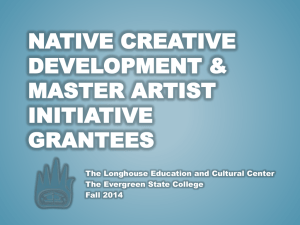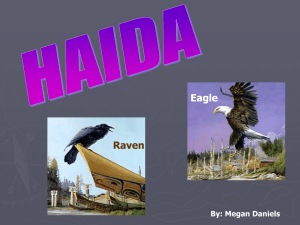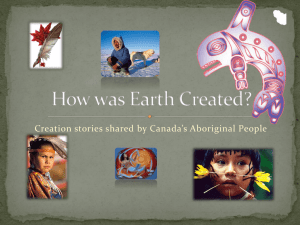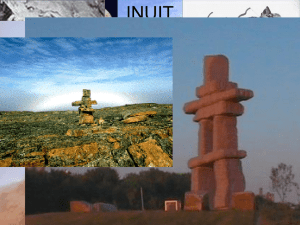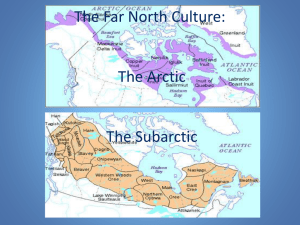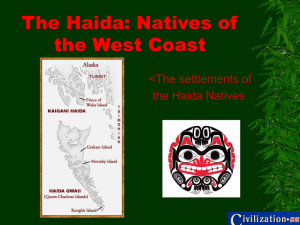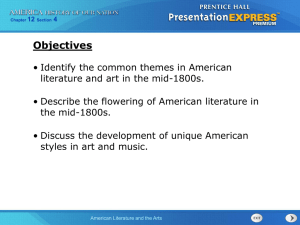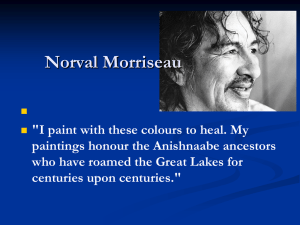Canadian Native Art - Visual Arts Penetanguishene Secondary School
advertisement
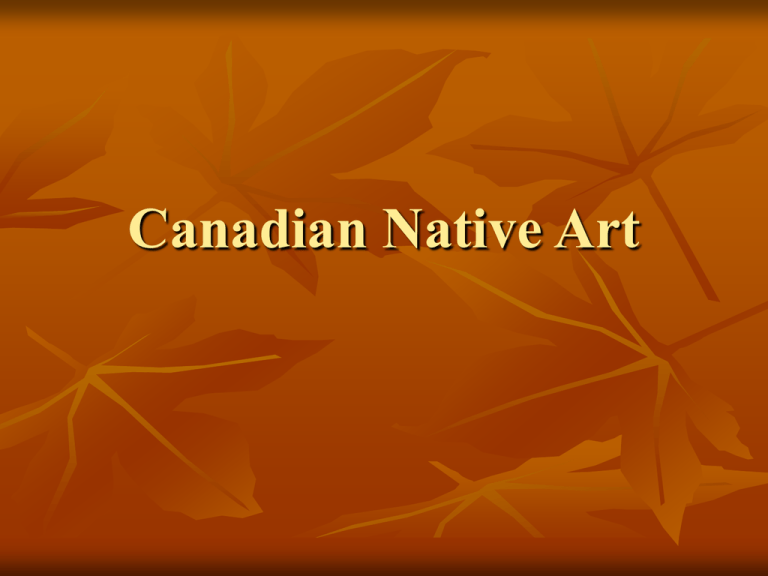
Canadian Native Art Native Art in Canada Canadian Native Peoples First off, Native peoples in Canada are often referred to as one group, but actually reflect many different cultures. Just like we understand that people from different European or Asian countries have different traditions, languages, histories and cuisines, the same is true for Native peoples. Canada is a huge country which is home to many different groups of Native peoples. This also means that there are many different types of Native art. Native Art in History Historically, to the native people, art was only one aspect of their lives. Art played a special role in their religious ceremonies. In some societies it was an important part of their political and social organization; and it helped to make useful objects attractive. Wampum Belt Wampum was used by the native people as currency and to record treaties and settle disputes Shaman’s Charm Shamans were expected to contact the spirit world by dancing and singing, so drums and rattles were important in their rituals. These items were often carved to represent their spirit helpers or painted with scenes of the shaman entering the land of the spirits. Interactions with Europeans The greatest change brought by Europeans was in technology. Indians were particularly keen to trade furs for glass beads and metal tools. Beads were far simpler to use for embroidery than porcupine quills. Before long, Indian women were using beads in all shapes and colours and quillwork became a skill of the past. Woollen cloth, too, was easier to obtain than skins and hides. On the Northwest Coast, metal tools caused a flourishing of wood carving for some years during the 19th century. Beaded Clothing Moccasins decorated with porcupine quills Native Artists Today Today, most native artists are painters, sculptors, and makers of prints and jewellery. Although they may use many of the traditional myths and styles in their art, they do it in new ways and with new materials. There are three main schools of contemporary native artists: Inuit art, West Coast Native art and the Woodlands school of "Legend Painters." Inuit Art The first "school" to rise to prominence was contemporary Inuit art, with sculpture appearing in the late 1940s, and then Inuit printmaking in the late 1950s. Inuit sculpture and prints remained the most popular and most successful in the marketplace during the 1960s and into the 1970s, when original drawings by individual Inuit artists came to be more fully recognized and valued. Contemporary Inuit sculpture, prints, drawings, and textiles may often employ Western artistic techniques and cater to an outsider market. At the same time, contemporary Inuit art exhibits numerous points of continuity with traditional Inuit culture, values, and world view. Kenojuak Ashevak Kenojuak Ashevak, was born on October 3, 1927, at Ikerrasak, Baffin Island, N.W.T. Kenojuak is one of Canada's most popular printmakers. She grew up in a traditional Inuit family, living off the land and moving camp as the seasons changed. She had many children, several of whom died in infancy. In the late 1950s, James Houston encouraged her and her husband, Johnniebo, to make some drawings for the new printmaking shop at Cape Dorset. Since that time, about 200 prints have been based on her work. She is best known for her drawings of birds, which are colourful and composed with a strong sense of design. Her most famous print, The Enchanted Owl, was reproduced on a postage stamp in 1967. She also carves in soapstone, and she and Johnniebo (now deceased) have been honoured with many awards, including the Companion of Canada, a National Film Board film, and a book about her work, and major exhibitions in galleries across Canada. In 2002 her work was featured in the exhibition Kenojuak Ashevak: To Make Something Beautiful at the National Gallery of Canada. She was awarded a Governor General's Award in Visual and Media Arts in 2008. Festival Owl Wolves in Spring The World Around Me The Enchanted Owl West Coast In the late 1960s and early 1970s a "renaissance" of Northwest Coast art in British Columbia occurred, with the appearance in abundance of traditional forms of woodcarving, metalwork, painting, prints and textiles at first among the "northern" nations (Haida, Tsimshian, and Kwakiutl) and more recently among the "southerly" Nootka and coast Salish. Famous artists include Tony Hunt and Robert Davidson who are skilled carvers of totem poles and masks. William Reid is famous for his sculpture, jewellery, and prints as well. Contemporary art is produced on the coast today for use in Native villages, but more often such traditional items as masks, rattles, boxes, bowls, textiles and jewellery are adapted to EuroCanadian techniques, materials, and functions for sale in Native art shops. Characteristics Use of formlines and the use of shapes referred to as ovoids, U forms and S forms. Media were wood, stone, and copper; since European contact, paper, canvas, glass, and precious metals have also been used. Common colours are red and black, but yellow is also often used, particularly among Kwakwaka'wakw artists. Patterns depicted include natural forms such as bears, ravens, eagles, and humans; legendary creatures such as thunderbirds and sisiutls; and abstract forms made up of the characteristic Northwest Coast shapes. Wooden Moon Mask Soul Catcher Totem Poles Bill Reid William Ronald Reid, was born on January 12, 1920, at Victoria, B.C. He died there on March 13, 1998. Bill Reid did more than anyone else to revive interest in Northwest Coast Native art and to create new art forms within the old traditions. He was the son of a Haida mother and a white father, but it was not until he was in his late teens that he learned anything about his native heritage. He worked as a broadcaster for 16 years, and in 1948-49 he took courses in jewellery-making in Toronto. He also began to study Native art in museums and books, and made his first trip to the land of his ancestors, the Queen Charlotte Islands. Before long he was recognized as an authority on Haida art and culture. Reid carved totem poles which contained complicated clan and family histories, but he also created simple sculptures which could be easily understood by people from other cultures. His huge wooden sculpture, Raven and the First Humans, at the Museum of Anthropology in Vancouver, tells the old story of the trickster raven who discovered the first Haida men in a giant clamshell; but Reid had given each a man a different expression as he peers out into the world or steals back into his shell . Bill Reid (Cont.) Bill Reid also worked in nontraditional materials. Outdoor sculptures, such as the Killer Whale, which rises from its own pool outside the Vancouver Aquarium, have been cast in bronze. He made exquisite jewellery and boxes in gold, silver, and argillite which were engraved with Haida designs. He was one of the first artists to use silkscreen prints to portray native art. And he wrote and illustrated many books about the culture and myths of his people. In 1986 Reid built a traditional dugout canoe for display at Expo 86 in Vancouver. Thunderbird Nanasimget Bracelet Thunderbird The Raven and the First Men Sockeye Salmon Pool Killer Whale Wolf Drum Grizzly Bear Necklace Woodlands School: The Legend Painters The Woodlands school has been influenced by Norval Morrisseau, a self-taught Ojibwa artist who was the first to paint the secret legends of his people. The Woodlands school gained recognition in the 1970s with Morrisseau’s rise to fame. The majority of Woodlands artists working from the 1970s into the 1980s have been inspired and influenced by Morrisseau and as a group are also known as Legend Painters for their depiction of imagery taken from spiritual and mythological traditions. Thunderbird Dreams Pride Ducks Norval Morrisseau Norval Morrisseau was born on March 14, 1932, at Sand Point Reserve, near Beardmore, Ont. He died on December 4, 2007, at Toronto, Ont. Morrisseau, or Copper Thunderbird as his name means in Ojibwa, was a self-taught artist who recorded the beliefs and legends of his people. He had little formal education, but had a close relationship with his grandfather, who taught him Ojibwa traditions. He developed a style of painting known as "Woodland Indian art" which combines features from both Indian rock painting and European art. In the 1960s, he was the first artist to break the barrier between native and European art in Canada. Using simple bold lines and strong bright colours, his "x-ray paintings" show the outside of bears, thunderbirds, and people as he sees them and their insides as he imagines them to be. Morrisseau (Cont.) The paintings, like the legends they are based on, are full of symbols and opposites - good and evil, human and animal, night and day. By exhibiting these sacred images to non-Indians, Morrisseau broke a tradition of secrecy and at first met with strong opposition from Ojibwa elders. He is now accepted, and many other "legend painters" have followed his style of painting. Through his writings and his art, Morrisseau hoped "to reassemble the pieces of a once-proud culture ... to show how dignified and brave my people once were. We were once a great people." Self Portrait of Artist – Astral Projection Mother and Child Fish and Loons From Lake Nipigon This Is The Way It Is Self Portrait A Vision To Its Soul Artistic Influence Native art influenced many non-native artists. Two famous artists influenced by native artwork and artistic styles are Emily Carr and Ted Harrison. Emily Carr Emily Carr was born on December 13, 1871, at Victoria, B.C., and she died there on March 2, 1945. Carr, who lived and worked alone on Vancouver Island, is one of Canada's most famous artists. Although she decided to be an artist early in life, it was only when she was 57 years old that she began the paintings and writing for which she is remembered. She studied art in San Francisco, in England, and visited France in 1910-11. 1908 she recorded the culture of the Northwest Coast native people, to paint their totem poles and carved log houses. Carr returned seriously to painting in 1927 when her work was exhibited in a national show in Ottawa. On her trip to the east, she met members of the Group of Seven, and Lawren Harris in particular encouraged and inspired her. She continued to paint Indian themes, but turned increasingly to nature. Her skies and forests are alive with energy, movement, and shimmering light. Indian Raven Indian Hut, Queen Charlotte Islands Skidgate Raven Indian Church Ted Harrison Edward Harrison was born on August 28, 1926, England. settled in the Yukon in 1968. He taught high school His paintings, many of life in the Yukon, have been shown in exhibitions across Canada. Harrison's first two children's books, Children of the Yukon (1977) and A Northern Alphabet (1982), use vivid colours to depict the rugged scenery and the variety of human activities in the North. The Blue Raven (1989) is the story of a heroic journey a Native boy makes to find help for his suffering people. Harrison has also illustrated Robert Service's The Cremation of Sam McGee (1986) and The Shooting of Dan McGrew (1988), two famous poems about the gold rush days of the 1890s. Ice Library Day The Boat Whale Frolic Emily’s Place
